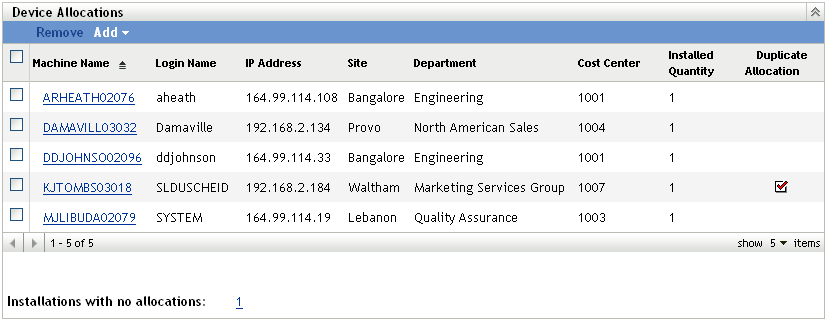15.1 Initializing Allocations
You can use the Initialize Allocations Wizard to create either device allocations or demographic allocations for a licensed product. After creating the initial allocations you can add additional allocations or modify the initial allocations.
If you plan to create demographic allocations, you should ensure that your devices and purchase records include the correct demographic data. For information, see Section 14.0, Preparing Demographic Data.
To initialize allocations for a licensed product:
-
In ZENworks Control Center, click the Asset Management tab.
-
On the License Management page, click Licensed Products.

-
In the Licensed Products list, select the check box next to the licensed product whose allocations you want to initialize.
You can select multiple products. If you do so, all selected products are initialized with the same type of allocation (device or demographic) from the same data source (Inventory device data or purchase records).
-
Click Action > Initialize Allocations, then click OK to acknowledge that any existing allocations for the selected products will be removed.
-
Complete the Initialize Allocations Wizard by using information from the following table to fill in the fields.
Wizard Page
Details
Allocation Type
Select Device if you want to allocate a license to each device that has the product installed.
Select Demographic, then select Site, Department, or Cost Center if you want to allocate licenses to sites, departments, or cost centers.
Allocation Data Source
If you are creating device allocations, the Initialize from Inventory option is the only enabled option. The wizard searches the Inventory data to find devices that have the product installed and then allocates a license to each device.
If you are creating demographic allocations, select the data source you want to use to create the license allocations:
-
Initialize from Purchase Records: Allocates licenses based on demographic data found in your purchase records.
For example, assume that you are initializing license allocations for ProductA based on the Department demographic. PurchaseRecord1 includes 10 ProductA licenses assigned to DepartmentQ. PurchaseRecord2 includes 20 ProductA licenses assigned to DepartmentZ. For ProductA, the wizard allocates 10 licenses to DepartmentQ and 20 licenses to DepartmentZ.
-
Initialize from Inventory: Allocates licenses based on demographic data associated with Inventory device data.
For example, assume that you are initializing license allocations for ProductA based on the Site demographic. Device1, Device2, and Device3 have ProductA installed. Device1 and Device2 are assigned to Site1 and Device3 is assigned to Site2. The wizard allocates two licenses to Site1 (for Device1 and Device2) and one license to Site 2 (for Device3).
-
Update License Allocations Based on Demographic Data in Future Purchase Record Imports: When importing future purchase records, updates the allocated license quantity if the purchase record contains the appropriate demographic data.
For example, assume that you import another purchase record that includes ProductA licenses that are assigned to DepartmentQ. The additional licenses are automatically reflected in the DepartmentQ demographic allocation.
Also creates new allocations if necessary. For example, if a purchase record includes ProductA licenses that are assigned to a DepartmentZ (a new department not listed in ProductA’s allocations), a new allocation for DepartmentZ is created.
Initialize Allocations Summary
Review your data.
-
-
If you have not already done so, click Finish to create the license allocations.
-
To see the license allocations, locate the licensed product in the Licensed Products list and click the number in the Allocated Quantity column.
Demographic allocations created by the wizard are listed in the Demographic Allocations panel.

The following information is provided for each demographic allocation:
-
Device Count: The number of devices assigned to the demographic. Click the number to display a list of the devices.
-
Allocated Quantity: The number of licenses allocated to the demographic. You can change this number to allocate more or fewer licenses.
-
Installed Quantity: The number of product installations on devices assigned to the demographic.
-
Variance: The difference between the number of allocated licenses and the number of product installations assigned to the demographic:
Allocated Quantity - Installed Quantity = Variance
A negative variance indicates more product installations than allocated licenses, and a positive variance indicates more allocated licenses than product installations.
Device allocations created by the wizard are listed in the Device Allocations panel.

The following information is provided for each device allocation:
-
Machine Name, Login Name, and IP Address: Standard information about the device, including the login name of the user who was logged in at the time the device was inventoried.
-
Site, Department, Cost Center: Demographic data about the device. If one or more of the fields is empty, the device’s inventory data does not contain that information.
-
Installed Quantity: The number of installations of the licensed product on the device. This should typically be 1.
-
Duplicate Allocation: Includes a check mark if the device’s installation is also included in a demographic allocation.
-
Installations with No Allocations: Displays the number of installations that are not allocated a license either through a demographic allocation or a device allocation. Click the number to display the list of installations.
-
-
If necessary, add additional allocations or modify the existing allocations. Refer to the following sections for instructions:
If you find that adding additional demographic data to devices or purchase records might result in better initial allocations for the product, you can add the data and then run the Initialize Allocations Wizard again. Any existing allocations are removed before the new ones are added.